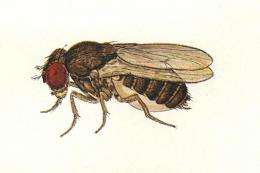September 28, 2012 weblog
Biologists discover why one species of fruit fly is dependent on a single cactus species

(Phys.org)—Researchers studying Drosophila pachea, a species of fruit fly that lives only in the Sonoran desert, have discovered why it is that the fly is wholly dependent on a single cactus species. It's due, they write in their paper published in the journal Science, to a mutation in a gene in a protein necessary for growth from larvae to adult, which allows the fly to convert a substance other than cholesterol to 7-dehydrocholesterol.
The researchers were interested in finding out why Drosophila pachea had become so wholly dependent on senita cactus because they believed it would lead to a better understanding of how changes to just a few genes in a species can lead to a restricted ecological niche. They knew going in that the fly was unable to convert cholesterol to 7-dehydrocholesterol (7DHC) as other flies do, and that the fly had evolved an ability to use other sterols to do the job, and also that the fly found its source in the senita cactus. What they didn't know was why the fly evolved to making the switch.
To find out, they looked more closely at the protein Neverland, the enzyme found in flies that is responsible for converting cholesterol to 7DHC, which is the beginning part of the process that allows larvae to grow to adults, expecting it to be absent in D. pachea, but it wasn't. Upon looking even closer they discovered that some of the amino acids in the version of Neverland found in D. pachea differed from those in other flies, which accounted for its ability to make the conversion using a different sterol instead called lathosterol, which just so happens to be found in senita cacti.
But that didn't explain why the fly had migrated to the new approach; to find the answer to that, the researchers gave lathosterol to other species of flies and found that they too were able to use it to produce 7DHC, and that in so doing appeared to gain a health benefit, more larvae made it to the adult stage, suggesting an inherent advantage feeding on senita cactus, which accounted for D. pachea's obvious preference for it, which led over time to it losing its ability to convert cholesterol to 7DHC.
The study shows, the team says, that evolutionary changes don't always lead to an expanded niche; sometimes, as in the case with D. pachea and senita cactus, the opposite is true.
More information: Mutations in the neverland Gene Turned Drosophila pachea into an Obligate Specialist Species, Science 28 September 2012: Vol. 337 no. 6102 pp. 1658-1661. DOI: 10.1126/science.1224829
ABSTRACT
Most living species exploit a limited range of resources. However, little is known about how tight associations build up during evolution between such specialist species and the hosts they use. We examined the dependence of Drosophila pachea on its single host, the senita cactus. Several amino acid changes in the Neverland oxygenase rendered D. pachea unable to transform cholesterol into 7-dehydrocholesterol (the first reaction in the steroid hormone biosynthetic pathway in insects) and thus made D. pachea dependent on the uncommon sterols of its host plant. The neverland mutations increase survival on the cactus's unusual sterols and are in a genomic region that faced recent positive selection. This study illustrates how relatively few genetic changes in a single gene may restrict the ecological niche of a species.
Journal information: Science
© 2012 Phys.org

















